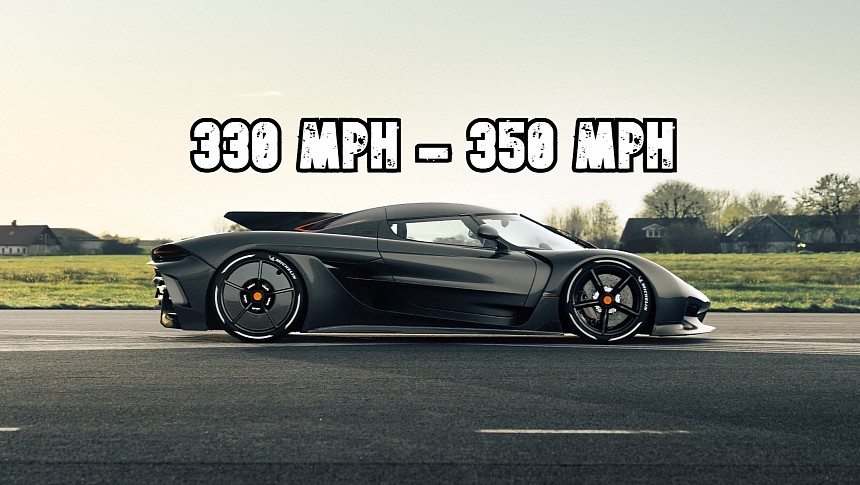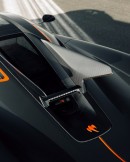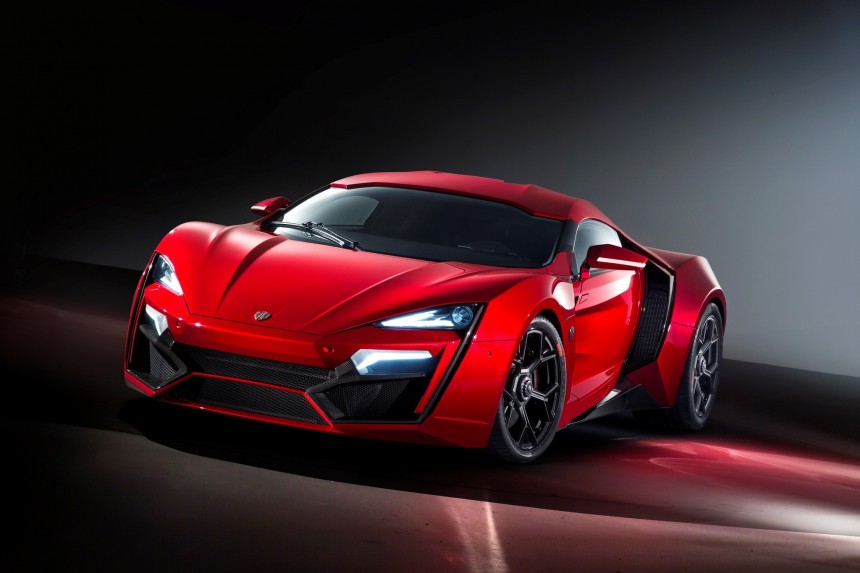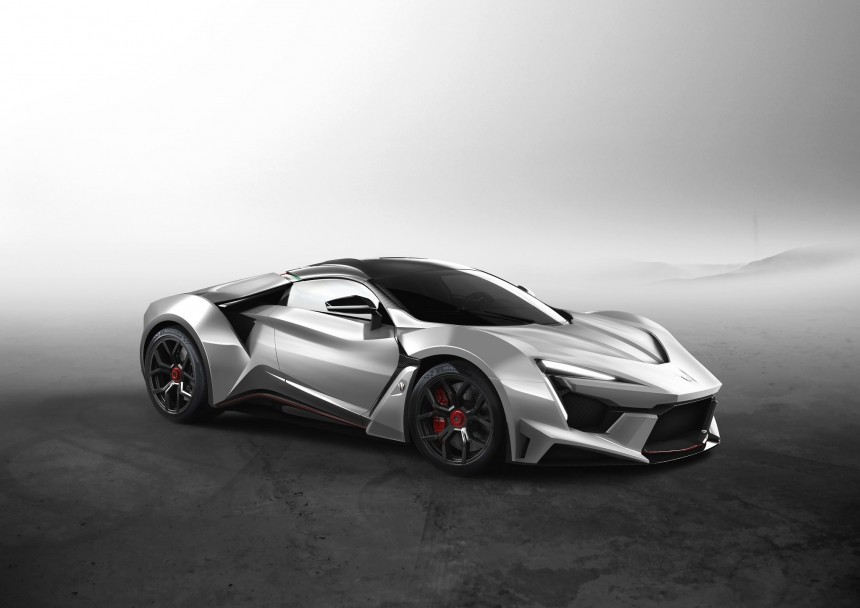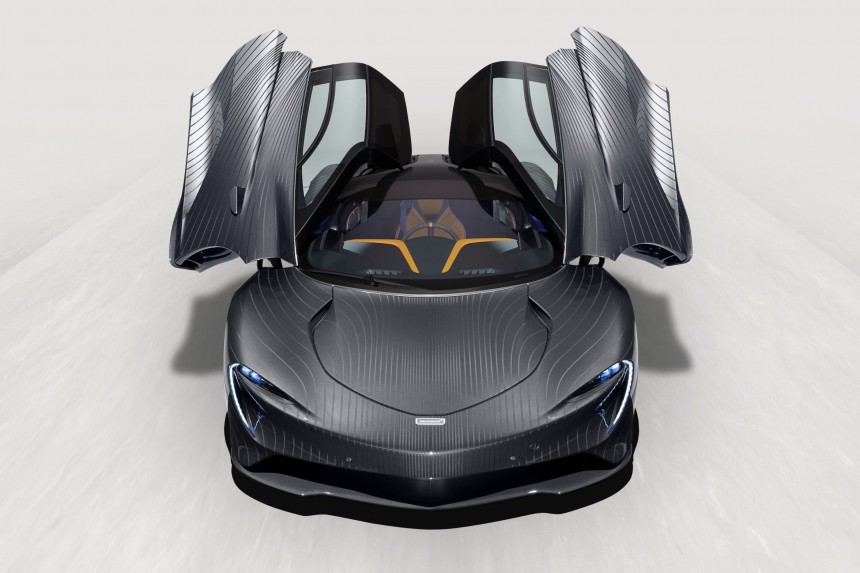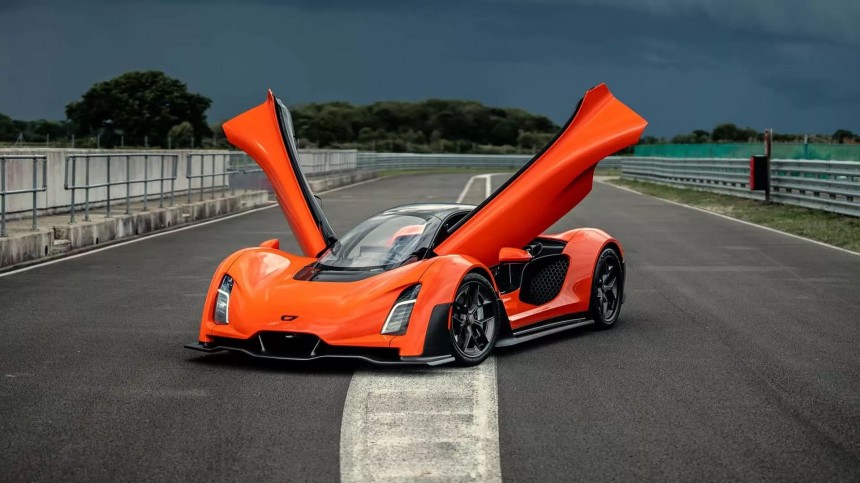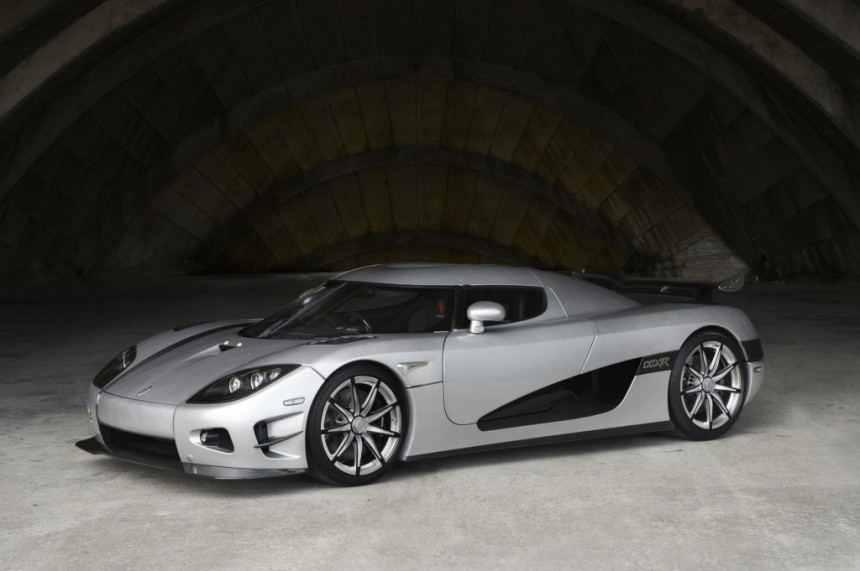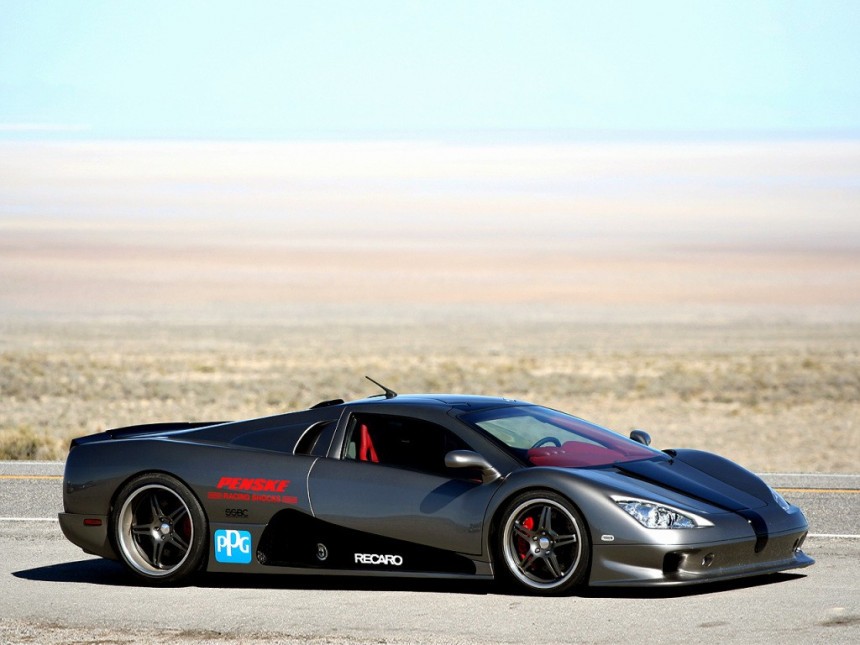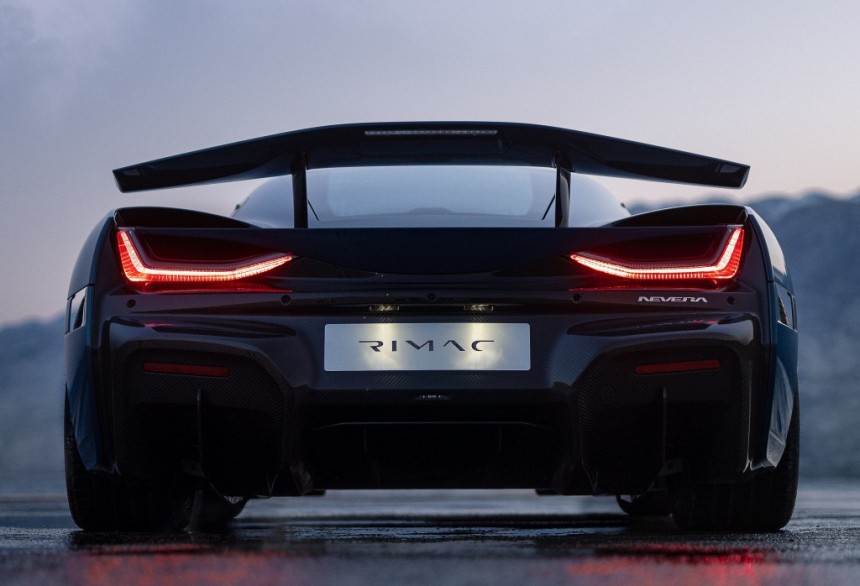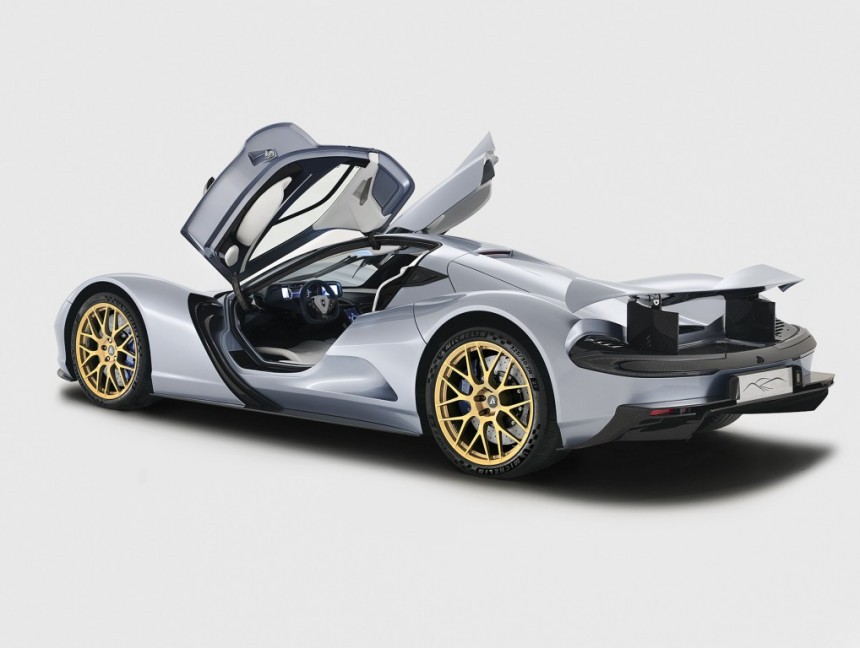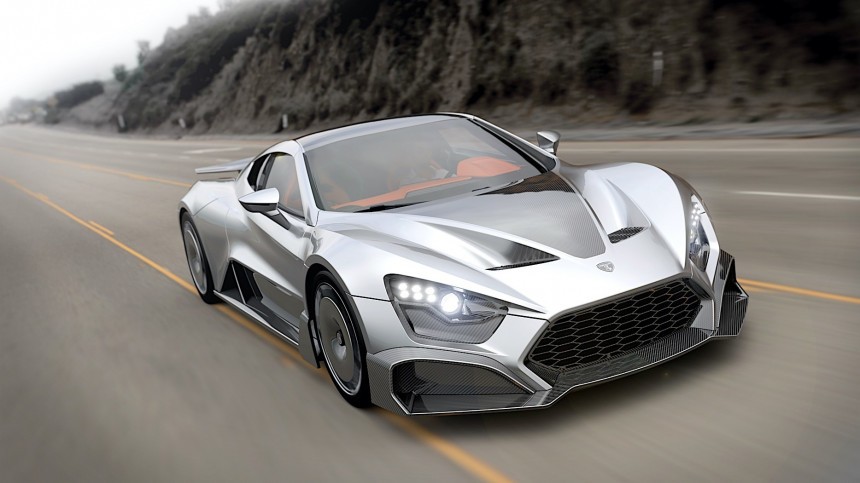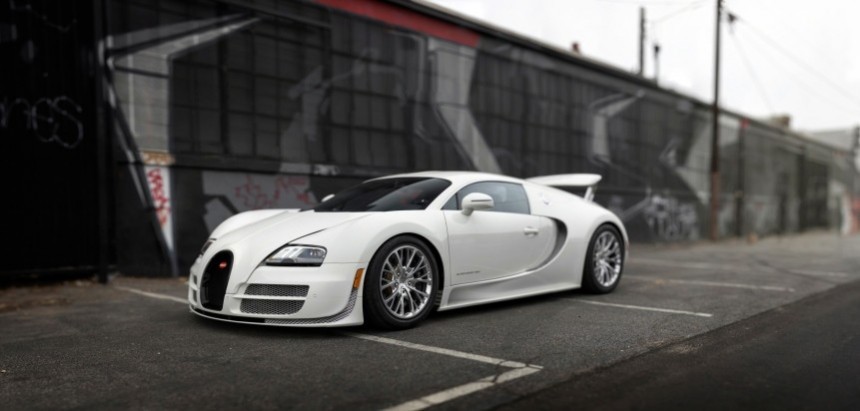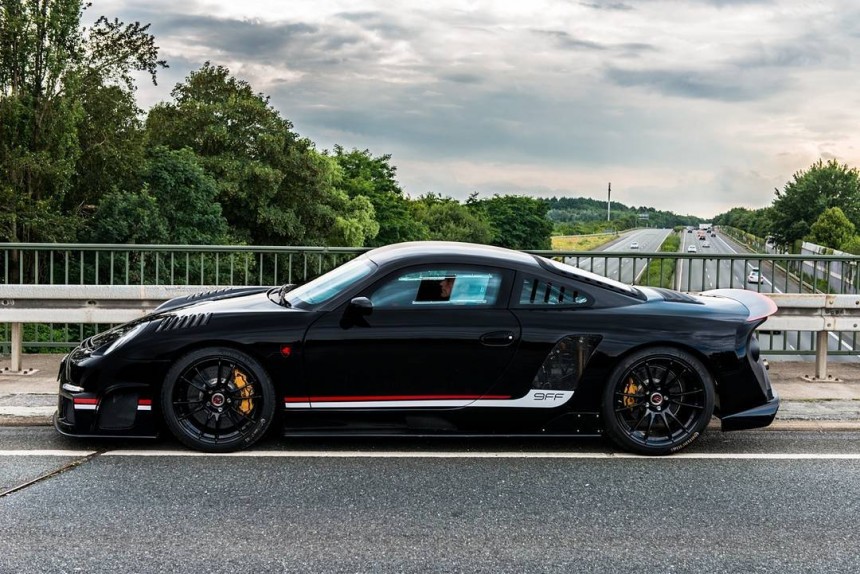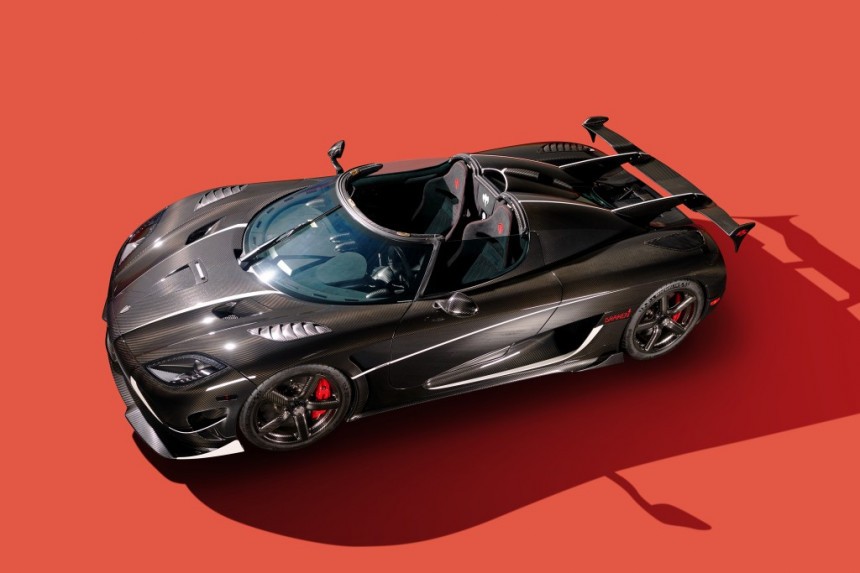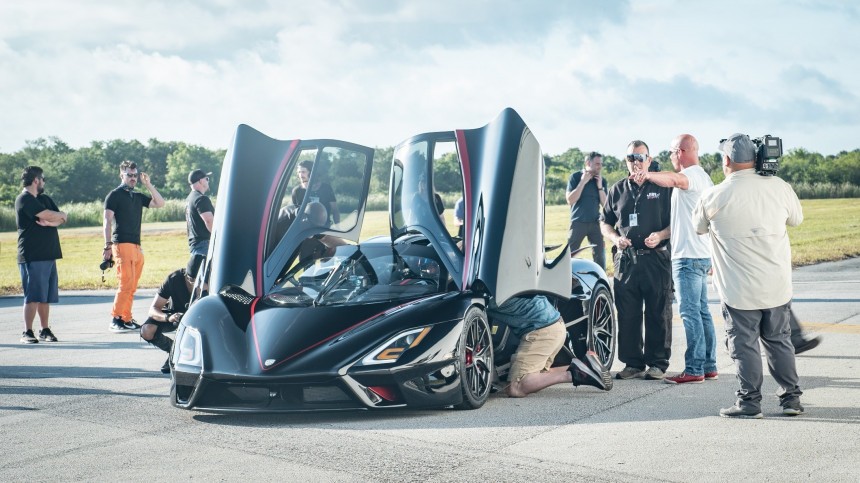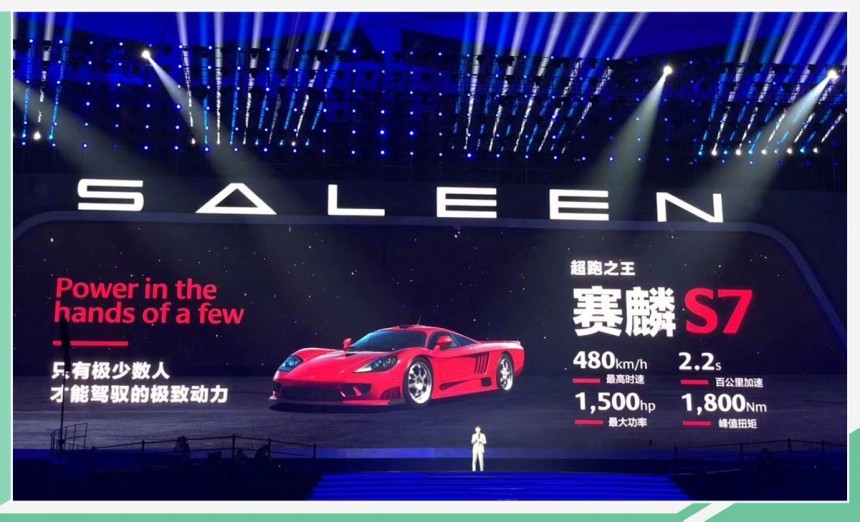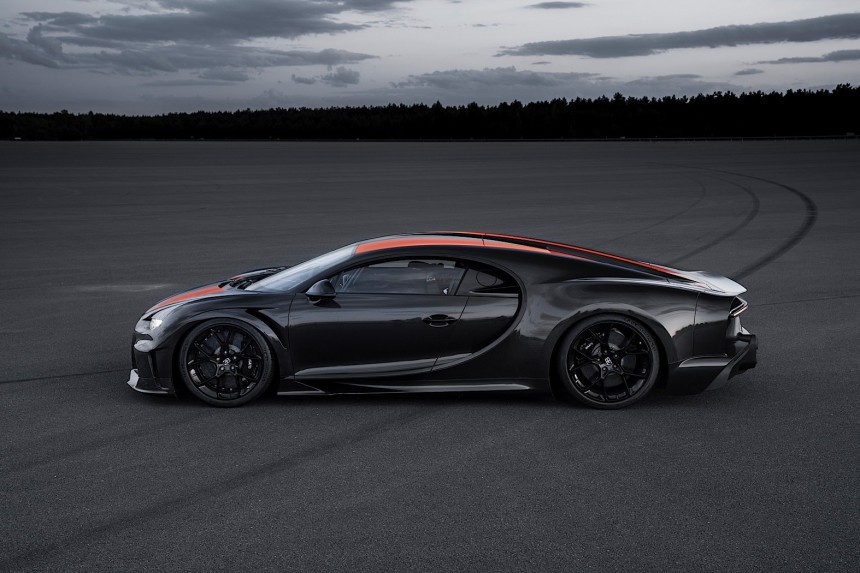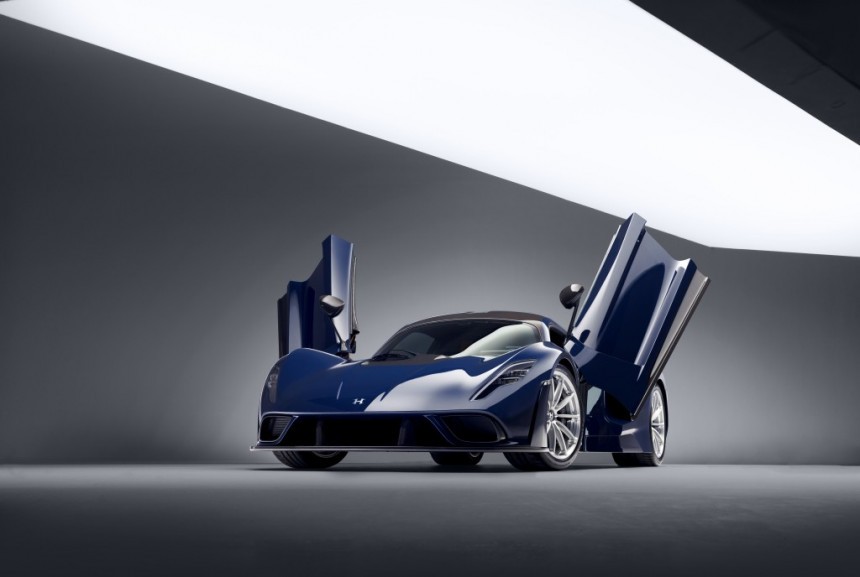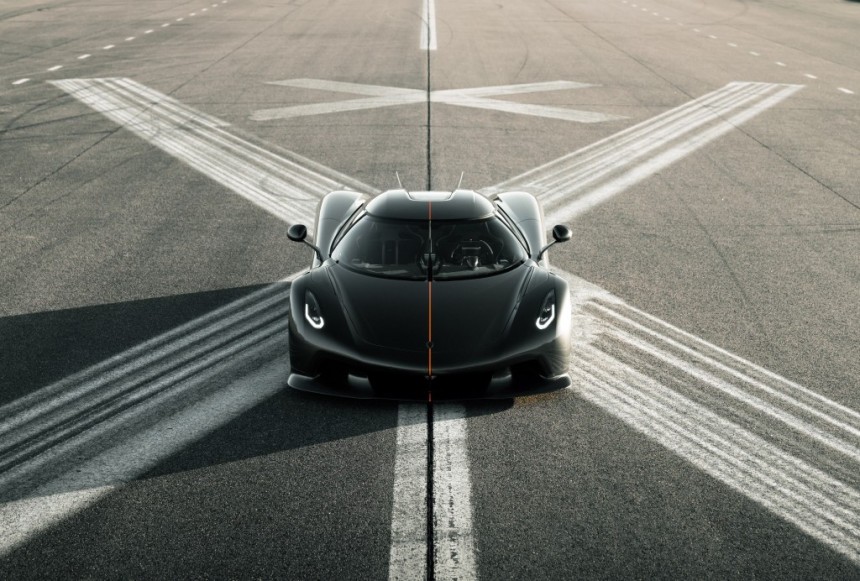Can a car go 400 miles per hour (644 kilometers per hour)? As far as road-legal automobiles are concerned, the answer is a clear and definitive no. At least for the time being, that is...
From the powertrain to the aero and tires, the current crop of high-speed exotica isn't capable of cracking 400 miles per hour. On the other hand, Bugatti did break into the 300s with a W16-engined monster.
That's 483 kilometers per hour converted to metric. Back in 2019, the Chiron Super Sport 300+ recorded 490.484 kilometers per hour at Volkswagen's test facility in Ehra-Lessien. That means 304.773 miles per hour, and there are production vehicles that promise more than that.
In compiling our list of the 20 fastest production cars of all time, we obviously excluded those that haven't started production yet (think Koenigsegg Gemera and SP Automotive Chaos) and those that are mere vaporware (think V16-engined Devel Sixteen and one-off Lotec Sirius). For the sake of diversity, only the fastest variant of a given model was selected for this list. To get to the 300-mph threshold, we first have to talk about 17 other unnervingly fast automobiles.
Transmission: 6-speed sequential or 7-speed DCT
Power and torque: 740 hp and 708 lb-ft
0 to 60 mph: 2.7 seconds
Price: $3.4 million
You might know this aggressive-looking car from Furious 7. Brian stated that W Motors would make only 7 examples of the breed, which is correct. On the other hand, Safar stated that its top speed is 242 miles per hour. He was off by a meager 3 mph.
Unveiled in 2013 at the Qatar Motor Show, the first supercar designed the Middle East is closely related to the Porsche 911. How come? For starters, it packs a Ruf-tuned Porsche 911 flat-six engine. Certain examples feature the PDK dual-clutch transmission, which premiered in the 997 gen.
Lighter than the 911 GT3 from that era, the Lykan HyperSport is unapologetically ostentatious due to 440 diamonds lined in the headlights. Gold stitching on the seats also needs to be mentioned. Believe it or not, one unit is currently serving with the Abu Dhabi Police Department in the UAE.
Transmission: 7-speed DCT
Power and torque: 799 hp and 723 lb-ft
0 to 60 mph: 2.6 seconds
Price: $1.9 million
SuperSport may indicate a lesser descendant, yet the Fenyr SuperSport is faster and more powerful than the Lykan HyperSport. Pretty weird, but remember that not everything has to make sense.
Once again, we're dealing with a Ruf-tuned boxer. Contrary to popular belief, Ruf is a manufacturer rather than a tuner. Its fastest road-legal car to date is the CTR 3 Clubsport, which is officially rated at 236 miles per hour (i.e., 380 kilometers per hour).
The HyperSport was assembled in Dubai, whereas the SuperSport is put together in Austria by the peeps at Magna Steyr. Production is limited to 100 standard models and a total of 10 launch editions.
Transmission: 7-speed DCT
Power and torque: 1,040 hp and 848 lb-ft
0 to 60 mph: 2.9 seconds
Price: £2.1 million ($2.6 million at current exchange rates)
Quite a long time ago, McLaren broke the speed record for naturally-aspirated cars with F1 XP5 at Ehra-Lessien. 243 miles per hour (391 kilometers per hour) is hugely impressive, and 25 years since then, said prototype still holds the speed record.
The F1 was originally succeeded by the P1, although indirectly. The actual replacement for the F1 is – of course – the Speedtail. Codenamed BP23, the three-seat hyper grand tourer is much obliged to accelerate to a ridiculous 250.4 mph (403 kph).
As incredible as it may sound, Speedtail XP2 topped out more than 30 times during high-speed evaluation at the Johnny Bohmer Proving Grounds in Florida. Only 106 customer vehicles ever left the Woking-based McLaren Technology Centre.
Transmission: Direct drive
Power and torque: 1,479 hp and 1,475 lb-ft
0 to 60 mph: 2.6 seconds
Price: €2.1 million ($2.25 million at current exchange rates)
Even though Regera production concluded in 2022, the folks at Koenigsegg proved that internal combustion is relevant in 2023 with a series of new records. Back in June, the plug-in hybrid V8-powered hypercar took a scant 28.81 seconds from zero to 400 kph (249 mph) and back to zero.
Equipped with Michelin Pilot Sport Cup 2 R street-legal track tires, the Regera in question also broke the record from zero to 250 mph (402.3 kph) and hard on the brakes to zero again in 29.6 seconds. Insane numbers, alright, precisely as expected from a certifiable off-the-wall piece of engineering.
The most unconventional thing about the Regera is Koenigsegg Direct Drive. Instead of a conventional transmission – be it manual, sequential, torque-converter auto, CVT, or DCT – Koenigsegg Direct Drive enables the combustion engine and electric motors to directly drive the big fat rear wheels.
Transmission: 7-speed sequential
Power and torque: 1,350 hp and over 1,061 lb-ft
0 to 60 mph: 1.7 seconds
Price: $2 million
Founded in 2019 by Kevin Czinger, the hypercar manufacturer from Los Angeles originally claimed 281 miles per hour (452 kilometers per hour) for the low-drag specification of the 21C. However, the American company's website currently reads 253 mph (407 kph) for the V Max.
Overpromising is extremely common in this particular business, yet 253 miles per hour is nothing to scoff at. For reference, a Boeing 737 airliner takes off at roughly 150 mph (241 kph).
Gifted with a central driving position and a passenger seat behind the driver's seat, the 21C further stands out with the help of its engine. Its twin-turbo V8 is the smallest powerplant ever fitted to a hypercar, for it displaces merely 2.88 liters.
Transmission: 6-speed manual or sequential
Power and torque: 1,004 hp and 782 lb-ft
0 to 60 mph: 2.9 seconds
Price: €4.45 million ($4.75 million at current exchange rates)
Initially limited to 3 examples, the Trevita would end production after 2 units were finished. The reason? Make that diamond-weave carbon fiber. One of those cars was owned by the one and only Floyd Mayweather, who parted ways with it back in 2017 at – somewhat surprisingly – a big loss.
The 2010 model sold for $2.6 million, which goes to show that rarity doesn't guarantee higher value in the automotive world. Mecum's estimate for the Trevita ranged from $2.7 million to $3.0 million.
Also worthy of note, the CCXR Trevita is tied with the CCXR Special Edition in terms of rarity. Be that as it may, the rarest member of the CCX line is the CCGT that never got the chance to race in the FIA GT Championship. The series folded in 2009, two years after Koenigsegg premiered the CCGT.
Transmission: 6-speed manual
Power and torque: 1,287 hp and 1,094 lb-ft
0 to 60 mph: 2.8 seconds
Price: $550,000
Founded by Jerod Shelby in 1998, SSC North America shouldn't be confused with Shelby American. Headquartered in Richland, Washington, the hypercar manufacturer completed the first prototype of the Ultimate Aero in 2004.
Three years later, the Ultimate Aero TT topped 257.11 miles per hour (413.83 kilometers per hour) on its first pass on a temporarily closed stretch of public highway. Supposedly good for up to 268 mph (432 kph) on full song, the subsequent Ultimate Aero XT never got the chance to stretch its legs. Even so, its actual maximum speed is estimated at… wait for it… the same 257 miles per hour as the record-breaking Ultimate Aero TT.
Offered from 2004 to 2013, the Ultimate Aero rocked everything from an LS1-based supercharged V8 to an SSC-designed 6.9L twin-turbo V8 for the XT. An electric version was also planned, yet the 208-mph (335-kph) Ultimate Aero EV never saw the light of series production.
Transmission: Direct drive
Power and torque: 1,888 hp and 1,741 lb-ft
0 to 60 mph: 1.74 seconds
Price: €2 million ($2.1 million at current exchange rates)
The only Croatian manufacturer on this list, Rimac limited the Nevera to 150 units. The very first example was delivered to a certain Nico Rosberg in late 2022. You know, the guy who beat Lewis Hamilton in equal machinery back in 2016. He announced his retirement from the dog-eat-dog world of Formula 1 five days after securing the title, besting Hamilton by five points after 21 races.
Previewed by the C_Two concept, Rimac's quad-motor EV flaunts no fewer than four inboard-mounted electric motors. Many publications incorrectly state 1,914 horsepower as the maximum output, confusing metric for mechanical ponies.
Last year, chief test and development driver Miro Zrncevic topped 412 kilometers per hour in an unrestricted Nevera at Automotive Testing Papenburg. Rimac says that converts to 258 miles per hour, yet that's actually 256 miles per hour. Customer vehicles are limited to 219 miles per hour (352 kilometers per hour) due to safety concerns.
Transmission: Direct drive
Power and torque: 1,953 hp and 1,416 lb-ft
0 to 60 mph: 1.72 seconds
Price: €2.9 million ($3.1 million at current exchange rates)
Rather than being a true hypercar manufacturer, Aspark is a Japanese company specialized in engineering services for the automotive, heavy, and electronics industries. That is precisely the reason why the Owl is made in Italy rather than Japan.
Manifattura Automobili Torino started assembling the world's fastest EV in 2020. Unveiled three years earlier at the 2017 Frankfurt Motor Show, the low-slung Owl boasts carbon-fiber everything, hydraulic suspension, carbon-ceramic brakes with 10-piston calipers up front, plus an active rear wing that extends at 93 mph (150 kph).
This fellow requires 8.73 seconds to run the quarter mile. By comparison, the Rimac Nevera needs 8.25 seconds and the Pininfarina Battista 8.55 seconds. When it comes to muscle cars, 8.91 seconds is the NHRA-certified ET of the fantastic Demon 170.
Transmission: 7-speed DCT
Power and torque: 1,341 hp and over 811 lb-ft
0 to 60 mph: 2.6 seconds
Price: N/A (likely over the €1.45 million of the TSR-S)
Danish manufacturer Zenvo rolled out the TSR-GT in November 2022. All three units were spoken for before the official unveiling, hence the lack of pricing information for this punchy land missile.
Derived from the high-downforce Zenvo TSR-S, the TSR-GT also packs a little more oomph. Its GM-based V8 is a twin-supercharged affair with a flat-plane crankshaft, designed for both dinosaur juice and E85 corn brew for an extra 180 ponies.
As opposed to 1,177 horsepower for the S, the GT makes 1,360 at full chatter. Peak torque hasn't been announced for some reason or another, yet we're certain its V8 produces more than the 1,100 Nm (811 pound-feet) of the track-oriented TSR-S.
Transmission: 6-speed manual or sequential
Power and torque: 1,243 hp and 1,180 lb-ft
0 to 60 mph: 1.8 seconds
Price: €980,000 ($1 million at current exchange rates)
Here is a name you've probably never heard of until today. M-racing Fahlke KFZ-Technik und Prototypenentwicklung is the automaker behind the Larea GT1, a racecar-inspired thriller available in four distinct flavors. The S12 is the most exciting of the bunch, for it belts out 1,243 horsepower.
Manufactured completely by hand, the GT1 S12 comes standard with an integrated racing data logger, ultra-light seats made from carbon fiber and Kevlar, and carbon-fiber body panels. More of a racecar than a road-going car, this no-nonsense automobile weighs 980 kgs (2,161 lbs) empty.
In combination with high-performance tires (measuring 335/30 by 18 inches out back), one has to wonder how good the GT1 S12 feels in the corners. It's not affordable, though. Compared to the €179,000 ($191,845) of the entry-level GT1 S7, the GT1 S12 is nearly 5.5 times more expensive.
Transmission: 7-speed DCT
Power and torque: 1,184 hp and 1,106 lb-ft
0 to 60 mph: 2.5 seconds
Price: €1,912,500 ($2 million at current exchange rates)
James May pushed a Veyron Super Sport to 417.61 kilometers per hour (259.49 miles per hour) on July 4, 2010. Later that day, French racing driver Pierre-Henri Raphanel averaged 431.072 kph (267.856 mph) at the Ehra-Lessien facility in Germany.
In the second high-speed run, the unrestricted Veyron Super Sport clocked a whopping 434.211 kilometers per hour, which converts to 269.806 miles per hour. Bugatti was originally disqualified by Guinness World Records because customer vehicles are limited to 415 kph (258 mph). Come April 2013, the record was finally confirmed.
Took them a long time to figure out that a software change doesn't alter the fundamental design of the car or its quad-turbo W16. Truth be told, WR16 is the correct designation for Bugatti's trademark engine because the 8.0L colossus is actually two 4.0L VR8 powerplants joined at 90 degrees.
Transmission: 6-speed manual
Power and torque: 1,244 hp and 1,155 lb-ft
0 to 60 mph: 2.5 seconds
Price: $1 million
The Lotus Elise was a hugely influential sports car. So influential, General Motors and Tesla both used its bonded and riveted aluminum chassis for the Opel Speedster (a.k.a. Vauxhall VX220 in the United Kingdom) and first-gen Tesla Roadster.
Hennessey also contracted Lotus for the Venom GT, which utilizes a heavily modified Elise chassis. How heavily modified? Let's say the Venom GT has a wheelbase of 2,800 millimeters (110.2 inches) compared to 2,300 (90.6) for the British model.
Sharing a Ricardo-supplied manual with the first-gen Ford GT, the Venom GT combines elements from both the LS7 and LS9 to create a truly unique twin-turbo small block. Oh, and by the way, did you know that Aerosmith's Steven Tyler masterminded the open-top Venom GT Spyder? He approached big kahuna John Hennessey with said request in 2011, and then took delivery of his car in 2012.
Transmission: 6-speed sequential
Power and torque: 1,381 hp and 856 lb-ft
0 to 60 mph: 2.9 seconds
Price: €895,000 ($960,000 at current exchange rates)
While not as obscure as the Fahlke Larea GT1 S12, the 9ff GT9 Vmax is rarely featured in listicles of the fastest cars of all time. Registered with the Federal Motor Transport Authority as a manufacturer, 9ff Engineering GmbH used the 997's platform to create a bonafide speed demon.
The GT9 originally topped 409 kilometers per hour (254 miles per hour), therefore falling short of the customer-spec Veyron Super Sport. Revealed at the 2012 Essen Motor Show, the GT9 Vmax features extensive modifications for a maximum speed of 437 kilometers per hour (272 miles per hour).
Longer and wider than a 997-generation 911 GT3, the GT9 Vmax uses 335-section rear tires compared to 305s for the Neunelfer. The tamest version of the GT9 in production today is the CS, which is officially rated at 364 kph (226 mph).
Transmission: 7-speed DCT
Power and torque: 1,341 hp and 1,011 lb-ft
0 to 60 mph: 2.8 seconds
Price: $1.65 million
November 2017 was a good month for the high-speed junkies at Koenigsegg. In a single day, the Agera RS claimed five world records for series-production vehicles, including top speed (457.94 kilometers per hour or 284.55 miles per hour).
The successor of the mighty One:1 was unveiled in 2015 at the Geneva Motor Show. The Agera RS known as Phoenix was commissioned by real estate investor Manny Khoshbin after his original car – dubbed Gryphon – was crashed by Koenigsegg during pre-delivery testing in 2017. Gryphon was rebuilt to be used as a development mule. One year later, it was crashed and rebuilt once again.
The Swedish automaker from Angelholm intended to produce no more than 25 units. Phoenix and Koenigsegg's original development mule brought the grand total to 27 units, with the final Agera RS rolling off the production line on April 4, 2018.
Transmission: 7-speed automated manual
Power and torque: 1,750 hp and 1,280 lb-ft
0 to 60 mph: 2.5 seconds
Price: $1.6 million
Eyebrows were raised in doubt when SSC North America claimed the Ultimate Aero-replacing Tuatara reached an absolute speed of 331.15 miles per hour (532.93 kilometers per hour) in October 2020. Guess what? That's way off the mark.
The company rebuked the naysayers, including Tim Burton (Shmee150) and Jason Fenske (Engineering Explained), saying that precision test and measurement equipment manufacturer Dewetron had validated both the first and second runs. Dewetron promptly denied any involvement in the record. Come July 2021, the automaker finally admitted that it "did not reach the originally claimed speeds of 331 mph or even 301 mph."
SSC North America ultimately redeemed itself with a customer's vehicle in May 2022, equipped with multiple satellite tracking devices to bring the point home. Said vehicle reached 295 miles per hour (474.8 kilometers per hour) at the Johnny Bohmer Proving Grounds. According to Jerod Shelby, the Tuatara has more to give. Had the runway been longer than 2.3 miles (3.7 kilometers), maybe it would have joined the esteemed 300-mph club.
Transmission: 6-speed manual
Power and torque: 1,500 hp and 1,328 lb-ft
0 to 60 mph: 2.0 seconds
Price: $1 million
Offered between 2000 and 2009, the S7 made a surprise return in 2017 with a special edition. The S7 LM originally touted 1,300 horsepower from a 351 Windsor-based 7.0L twin-turbo V8 engine.
Two years later, during a press conference in China of all places, output ratings were updated to 1,500 horsepower and 1,326 pound-feet (1,800 Nm). Saleen further stated 2.2 seconds to 100 kilometers per hour (62 miles per hour), which means 2.0 seconds flat or thereabout from zero to 60 mph.
The highlight came in the form of 480 kilometers per hour (298 miles per hour) for top speed. Wishful thinking? Maybe. Even if Saleen did inflate said numbers, the S7 would've still made this list because the S7 Twin Turbo exceeds 240 mph (386 kph) on a long enough stretch of runway.
Transmission: 7-speed DCT
Power and torque: 1,578 hp and 1,180 lb-ft
0 to 60 mph: 2.3 seconds
Price: €3.5 million ($3.75 million at current exchange rates)
La Voiture Noire may be the priciest Chiron-based hypercar out there, but it doesn't hold a candle to the top speed of the Super Sport 300+. Rather curiously for a French automaker controlled by Germany's Volkswagen Group, 300+ refers to miles per hour instead of kilometers per hour.
August 2, 2019 saw Andy Wallace take a pre-production prototype to 304.773 miles per hour (490.484 kilometers per hour) at the Ehra-Lessien facility, with said top speed verified by Germany's Technical Inspection Association. Similar to the Rimac Nevera, customer vehicles are limited.
273 miles per hour (440 kilometers per hour) still is monumental, cementing the Chiron Super Sport 300+ in the pantheon of four-wheeled and street-legal greats. Only 30 units were produced. The final car left Bugatti's Molsheim facility in July 2022.
Transmission: 7-speed automated manual
Power and torque: 1,817 hp and 1,193 lb-ft
0 to 60 mph: 2.6 seconds
Price: $1.6 million
We all know that GT stands for grand tourer. F5, meanwhile, refers to the highest rating on the Fujita scale for tornados. F5 is how meteorologists classify those ultra-violent tornados with wind speeds ranging between 261 and 318 miles per hour or – in metric – 420 to 512 kilometers per hour.
311 is the claimed top speed in miles per hour, yet Hennessey Special Vehicles hasn't maxed out the F5 thus far. Speaking to Top Gear in January 2023, founder John Hennessey promised that a 300-plus-mph run would happen in the next 12 months.
At press time, we're less than four months away from January 2024. Hennessey also claims that it's targeting a two-way average of 300-plus miles per hour. According to John Hennessey, the F5 needs anything between 5 and 7 miles (8.0 to 11.2 kilometers) of highway to reach its top speed.
Transmission: 9-speed MCT
Power and torque: 1,578 hp and 1,106 lb-ft
0 to 60 mph: 2.5 seconds
Price: $3 million
Named after Christian von Koenigsegg's father, the Jesko comes in two flavors: Attack for the corners and Absolut for the straightaways. The more slippery of the siblings is projected to reach 330 to 350 miles per hour, which converts to 531 and 563 kilometers per hour in the metric system.
Boasting a frontal area of 1.88 square meters and 0.278 in terms of drag coefficient, the Jesko Absolut runs on super premium and E85. The ethanol blend enables the Swedish hypercar's 5.1L twin-turbocharged V8 to give it all it's got.
Both the Attack and Absolut use a clever multi-clutch transmission advertised as the Light Speed Transmission. It weighs only 90 kilos (198 pounds), thus bringing the curb weight down to 1,390 kilos (3,064 pounds) for the Absolut.
That being said, we're eagerly waiting to find out if the Absolut is indeed faster than the F5.
That's 483 kilometers per hour converted to metric. Back in 2019, the Chiron Super Sport 300+ recorded 490.484 kilometers per hour at Volkswagen's test facility in Ehra-Lessien. That means 304.773 miles per hour, and there are production vehicles that promise more than that.
In compiling our list of the 20 fastest production cars of all time, we obviously excluded those that haven't started production yet (think Koenigsegg Gemera and SP Automotive Chaos) and those that are mere vaporware (think V16-engined Devel Sixteen and one-off Lotec Sirius). For the sake of diversity, only the fastest variant of a given model was selected for this list. To get to the 300-mph threshold, we first have to talk about 17 other unnervingly fast automobiles.
20. W Motors Lykan HyperSport: 245 mph
Engine: 3.8L twin-turbo H6Transmission: 6-speed sequential or 7-speed DCT
Power and torque: 740 hp and 708 lb-ft
0 to 60 mph: 2.7 seconds
Price: $3.4 million
Unveiled in 2013 at the Qatar Motor Show, the first supercar designed the Middle East is closely related to the Porsche 911. How come? For starters, it packs a Ruf-tuned Porsche 911 flat-six engine. Certain examples feature the PDK dual-clutch transmission, which premiered in the 997 gen.
Lighter than the 911 GT3 from that era, the Lykan HyperSport is unapologetically ostentatious due to 440 diamonds lined in the headlights. Gold stitching on the seats also needs to be mentioned. Believe it or not, one unit is currently serving with the Abu Dhabi Police Department in the UAE.
19. W Motors Fenyr SuperSport: 249 mph
Engine: 3.8L twin-turbo H6Transmission: 7-speed DCT
Power and torque: 799 hp and 723 lb-ft
0 to 60 mph: 2.6 seconds
Price: $1.9 million
Once again, we're dealing with a Ruf-tuned boxer. Contrary to popular belief, Ruf is a manufacturer rather than a tuner. Its fastest road-legal car to date is the CTR 3 Clubsport, which is officially rated at 236 miles per hour (i.e., 380 kilometers per hour).
The HyperSport was assembled in Dubai, whereas the SuperSport is put together in Austria by the peeps at Magna Steyr. Production is limited to 100 standard models and a total of 10 launch editions.
18. McLaren Speedtail: 250 mph
Engine: 4.0L twin-turbo V8 hybridTransmission: 7-speed DCT
Power and torque: 1,040 hp and 848 lb-ft
0 to 60 mph: 2.9 seconds
Price: £2.1 million ($2.6 million at current exchange rates)
The F1 was originally succeeded by the P1, although indirectly. The actual replacement for the F1 is – of course – the Speedtail. Codenamed BP23, the three-seat hyper grand tourer is much obliged to accelerate to a ridiculous 250.4 mph (403 kph).
As incredible as it may sound, Speedtail XP2 topped out more than 30 times during high-speed evaluation at the Johnny Bohmer Proving Grounds in Florida. Only 106 customer vehicles ever left the Woking-based McLaren Technology Centre.
17. Koenigsegg Regera: 251 mph
Engine: 5.0L twin-turbo V8 plug-in hybridTransmission: Direct drive
Power and torque: 1,479 hp and 1,475 lb-ft
0 to 60 mph: 2.6 seconds
Price: €2.1 million ($2.25 million at current exchange rates)
Equipped with Michelin Pilot Sport Cup 2 R street-legal track tires, the Regera in question also broke the record from zero to 250 mph (402.3 kph) and hard on the brakes to zero again in 29.6 seconds. Insane numbers, alright, precisely as expected from a certifiable off-the-wall piece of engineering.
The most unconventional thing about the Regera is Koenigsegg Direct Drive. Instead of a conventional transmission – be it manual, sequential, torque-converter auto, CVT, or DCT – Koenigsegg Direct Drive enables the combustion engine and electric motors to directly drive the big fat rear wheels.
16. Czinger 21C V Max: 253 mph
Engine: 2.88L twin-turbo V8 hybridTransmission: 7-speed sequential
Power and torque: 1,350 hp and over 1,061 lb-ft
0 to 60 mph: 1.7 seconds
Price: $2 million
Founded in 2019 by Kevin Czinger, the hypercar manufacturer from Los Angeles originally claimed 281 miles per hour (452 kilometers per hour) for the low-drag specification of the 21C. However, the American company's website currently reads 253 mph (407 kph) for the V Max.
Overpromising is extremely common in this particular business, yet 253 miles per hour is nothing to scoff at. For reference, a Boeing 737 airliner takes off at roughly 150 mph (241 kph).
Gifted with a central driving position and a passenger seat behind the driver's seat, the 21C further stands out with the help of its engine. Its twin-turbo V8 is the smallest powerplant ever fitted to a hypercar, for it displaces merely 2.88 liters.
15. Koenigsegg CCXR Trevita: 254 mph
Engine: 4.8L twin-supercharged V8Transmission: 6-speed manual or sequential
Power and torque: 1,004 hp and 782 lb-ft
0 to 60 mph: 2.9 seconds
Price: €4.45 million ($4.75 million at current exchange rates)
The 2010 model sold for $2.6 million, which goes to show that rarity doesn't guarantee higher value in the automotive world. Mecum's estimate for the Trevita ranged from $2.7 million to $3.0 million.
Also worthy of note, the CCXR Trevita is tied with the CCXR Special Edition in terms of rarity. Be that as it may, the rarest member of the CCX line is the CCGT that never got the chance to race in the FIA GT Championship. The series folded in 2009, two years after Koenigsegg premiered the CCGT.
14. SSC Ultimate Aero TT: 257 mph
Engine: 6.3L twin-turbo V8Transmission: 6-speed manual
Power and torque: 1,287 hp and 1,094 lb-ft
0 to 60 mph: 2.8 seconds
Price: $550,000
Three years later, the Ultimate Aero TT topped 257.11 miles per hour (413.83 kilometers per hour) on its first pass on a temporarily closed stretch of public highway. Supposedly good for up to 268 mph (432 kph) on full song, the subsequent Ultimate Aero XT never got the chance to stretch its legs. Even so, its actual maximum speed is estimated at… wait for it… the same 257 miles per hour as the record-breaking Ultimate Aero TT.
Offered from 2004 to 2013, the Ultimate Aero rocked everything from an LS1-based supercharged V8 to an SSC-designed 6.9L twin-turbo V8 for the XT. An electric version was also planned, yet the 208-mph (335-kph) Ultimate Aero EV never saw the light of series production.
13. Rimac Nevera: 256 mph
Engine: 4 inboard electric motorsTransmission: Direct drive
Power and torque: 1,888 hp and 1,741 lb-ft
0 to 60 mph: 1.74 seconds
Price: €2 million ($2.1 million at current exchange rates)
Previewed by the C_Two concept, Rimac's quad-motor EV flaunts no fewer than four inboard-mounted electric motors. Many publications incorrectly state 1,914 horsepower as the maximum output, confusing metric for mechanical ponies.
Last year, chief test and development driver Miro Zrncevic topped 412 kilometers per hour in an unrestricted Nevera at Automotive Testing Papenburg. Rimac says that converts to 258 miles per hour, yet that's actually 256 miles per hour. Customer vehicles are limited to 219 miles per hour (352 kilometers per hour) due to safety concerns.
12. Aspark Owl: 257 mph
Engine: 4 in-wheel electric motorsTransmission: Direct drive
Power and torque: 1,953 hp and 1,416 lb-ft
0 to 60 mph: 1.72 seconds
Price: €2.9 million ($3.1 million at current exchange rates)
Manifattura Automobili Torino started assembling the world's fastest EV in 2020. Unveiled three years earlier at the 2017 Frankfurt Motor Show, the low-slung Owl boasts carbon-fiber everything, hydraulic suspension, carbon-ceramic brakes with 10-piston calipers up front, plus an active rear wing that extends at 93 mph (150 kph).
This fellow requires 8.73 seconds to run the quarter mile. By comparison, the Rimac Nevera needs 8.25 seconds and the Pininfarina Battista 8.55 seconds. When it comes to muscle cars, 8.91 seconds is the NHRA-certified ET of the fantastic Demon 170.
11. Zenvo TSR-GT: 263 mph
Engine: 5.8L twin-supercharged V8Transmission: 7-speed DCT
Power and torque: 1,341 hp and over 811 lb-ft
0 to 60 mph: 2.6 seconds
Price: N/A (likely over the €1.45 million of the TSR-S)
Derived from the high-downforce Zenvo TSR-S, the TSR-GT also packs a little more oomph. Its GM-based V8 is a twin-supercharged affair with a flat-plane crankshaft, designed for both dinosaur juice and E85 corn brew for an extra 180 ponies.
As opposed to 1,177 horsepower for the S, the GT makes 1,360 at full chatter. Peak torque hasn't been announced for some reason or another, yet we're certain its V8 produces more than the 1,100 Nm (811 pound-feet) of the track-oriented TSR-S.
10. Fahlke Larea GT1 S12: 267 mph
Engine: 7.2L supercharged V8Transmission: 6-speed manual or sequential
Power and torque: 1,243 hp and 1,180 lb-ft
0 to 60 mph: 1.8 seconds
Price: €980,000 ($1 million at current exchange rates)
Manufactured completely by hand, the GT1 S12 comes standard with an integrated racing data logger, ultra-light seats made from carbon fiber and Kevlar, and carbon-fiber body panels. More of a racecar than a road-going car, this no-nonsense automobile weighs 980 kgs (2,161 lbs) empty.
In combination with high-performance tires (measuring 335/30 by 18 inches out back), one has to wonder how good the GT1 S12 feels in the corners. It's not affordable, though. Compared to the €179,000 ($191,845) of the entry-level GT1 S7, the GT1 S12 is nearly 5.5 times more expensive.
9. Bugatti Veyron Super Sport: 270 mph
Engine: 8.0L quad-turbo W16Transmission: 7-speed DCT
Power and torque: 1,184 hp and 1,106 lb-ft
0 to 60 mph: 2.5 seconds
Price: €1,912,500 ($2 million at current exchange rates)
James May pushed a Veyron Super Sport to 417.61 kilometers per hour (259.49 miles per hour) on July 4, 2010. Later that day, French racing driver Pierre-Henri Raphanel averaged 431.072 kph (267.856 mph) at the Ehra-Lessien facility in Germany.
In the second high-speed run, the unrestricted Veyron Super Sport clocked a whopping 434.211 kilometers per hour, which converts to 269.806 miles per hour. Bugatti was originally disqualified by Guinness World Records because customer vehicles are limited to 415 kph (258 mph). Come April 2013, the record was finally confirmed.
Took them a long time to figure out that a software change doesn't alter the fundamental design of the car or its quad-turbo W16. Truth be told, WR16 is the correct designation for Bugatti's trademark engine because the 8.0L colossus is actually two 4.0L VR8 powerplants joined at 90 degrees.
8. Hennessey Venom GT: 270 mph
Engine: 7.0L twin-turbo V8Transmission: 6-speed manual
Power and torque: 1,244 hp and 1,155 lb-ft
0 to 60 mph: 2.5 seconds
Price: $1 million
The Lotus Elise was a hugely influential sports car. So influential, General Motors and Tesla both used its bonded and riveted aluminum chassis for the Opel Speedster (a.k.a. Vauxhall VX220 in the United Kingdom) and first-gen Tesla Roadster.
Hennessey also contracted Lotus for the Venom GT, which utilizes a heavily modified Elise chassis. How heavily modified? Let's say the Venom GT has a wheelbase of 2,800 millimeters (110.2 inches) compared to 2,300 (90.6) for the British model.
Sharing a Ricardo-supplied manual with the first-gen Ford GT, the Venom GT combines elements from both the LS7 and LS9 to create a truly unique twin-turbo small block. Oh, and by the way, did you know that Aerosmith's Steven Tyler masterminded the open-top Venom GT Spyder? He approached big kahuna John Hennessey with said request in 2011, and then took delivery of his car in 2012.
7. 9ff GT9 Vmax: 272 mph
Engine: 4.2L twin-turbo H6Transmission: 6-speed sequential
Power and torque: 1,381 hp and 856 lb-ft
0 to 60 mph: 2.9 seconds
Price: €895,000 ($960,000 at current exchange rates)
While not as obscure as the Fahlke Larea GT1 S12, the 9ff GT9 Vmax is rarely featured in listicles of the fastest cars of all time. Registered with the Federal Motor Transport Authority as a manufacturer, 9ff Engineering GmbH used the 997's platform to create a bonafide speed demon.
The GT9 originally topped 409 kilometers per hour (254 miles per hour), therefore falling short of the customer-spec Veyron Super Sport. Revealed at the 2012 Essen Motor Show, the GT9 Vmax features extensive modifications for a maximum speed of 437 kilometers per hour (272 miles per hour).
Longer and wider than a 997-generation 911 GT3, the GT9 Vmax uses 335-section rear tires compared to 305s for the Neunelfer. The tamest version of the GT9 in production today is the CS, which is officially rated at 364 kph (226 mph).
6. Koenigsegg Agera RS: 285 mph
Engine: 5.1L twin-turbo V8Transmission: 7-speed DCT
Power and torque: 1,341 hp and 1,011 lb-ft
0 to 60 mph: 2.8 seconds
Price: $1.65 million
November 2017 was a good month for the high-speed junkies at Koenigsegg. In a single day, the Agera RS claimed five world records for series-production vehicles, including top speed (457.94 kilometers per hour or 284.55 miles per hour).
The successor of the mighty One:1 was unveiled in 2015 at the Geneva Motor Show. The Agera RS known as Phoenix was commissioned by real estate investor Manny Khoshbin after his original car – dubbed Gryphon – was crashed by Koenigsegg during pre-delivery testing in 2017. Gryphon was rebuilt to be used as a development mule. One year later, it was crashed and rebuilt once again.
The Swedish automaker from Angelholm intended to produce no more than 25 units. Phoenix and Koenigsegg's original development mule brought the grand total to 27 units, with the final Agera RS rolling off the production line on April 4, 2018.
5. SSC Tuatara: 295 mph
Engine: 5.9L twin-turbo V8Transmission: 7-speed automated manual
Power and torque: 1,750 hp and 1,280 lb-ft
0 to 60 mph: 2.5 seconds
Price: $1.6 million
Eyebrows were raised in doubt when SSC North America claimed the Ultimate Aero-replacing Tuatara reached an absolute speed of 331.15 miles per hour (532.93 kilometers per hour) in October 2020. Guess what? That's way off the mark.
The company rebuked the naysayers, including Tim Burton (Shmee150) and Jason Fenske (Engineering Explained), saying that precision test and measurement equipment manufacturer Dewetron had validated both the first and second runs. Dewetron promptly denied any involvement in the record. Come July 2021, the automaker finally admitted that it "did not reach the originally claimed speeds of 331 mph or even 301 mph."
SSC North America ultimately redeemed itself with a customer's vehicle in May 2022, equipped with multiple satellite tracking devices to bring the point home. Said vehicle reached 295 miles per hour (474.8 kilometers per hour) at the Johnny Bohmer Proving Grounds. According to Jerod Shelby, the Tuatara has more to give. Had the runway been longer than 2.3 miles (3.7 kilometers), maybe it would have joined the esteemed 300-mph club.
4. Saleen S7 LM: 298 mph
Engine: 7.0L twin-turbo V8Transmission: 6-speed manual
Power and torque: 1,500 hp and 1,328 lb-ft
0 to 60 mph: 2.0 seconds
Price: $1 million
Offered between 2000 and 2009, the S7 made a surprise return in 2017 with a special edition. The S7 LM originally touted 1,300 horsepower from a 351 Windsor-based 7.0L twin-turbo V8 engine.
Two years later, during a press conference in China of all places, output ratings were updated to 1,500 horsepower and 1,326 pound-feet (1,800 Nm). Saleen further stated 2.2 seconds to 100 kilometers per hour (62 miles per hour), which means 2.0 seconds flat or thereabout from zero to 60 mph.
The highlight came in the form of 480 kilometers per hour (298 miles per hour) for top speed. Wishful thinking? Maybe. Even if Saleen did inflate said numbers, the S7 would've still made this list because the S7 Twin Turbo exceeds 240 mph (386 kph) on a long enough stretch of runway.
3. Bugatti Chiron Super Sport 300+: 305 mph
Engine: 8.0L quad-turbo W16Transmission: 7-speed DCT
Power and torque: 1,578 hp and 1,180 lb-ft
0 to 60 mph: 2.3 seconds
Price: €3.5 million ($3.75 million at current exchange rates)
La Voiture Noire may be the priciest Chiron-based hypercar out there, but it doesn't hold a candle to the top speed of the Super Sport 300+. Rather curiously for a French automaker controlled by Germany's Volkswagen Group, 300+ refers to miles per hour instead of kilometers per hour.
August 2, 2019 saw Andy Wallace take a pre-production prototype to 304.773 miles per hour (490.484 kilometers per hour) at the Ehra-Lessien facility, with said top speed verified by Germany's Technical Inspection Association. Similar to the Rimac Nevera, customer vehicles are limited.
273 miles per hour (440 kilometers per hour) still is monumental, cementing the Chiron Super Sport 300+ in the pantheon of four-wheeled and street-legal greats. Only 30 units were produced. The final car left Bugatti's Molsheim facility in July 2022.
2. Hennessey Venom F5: 311 mph
Engine: 6.6L twin-turbo V8Transmission: 7-speed automated manual
Power and torque: 1,817 hp and 1,193 lb-ft
0 to 60 mph: 2.6 seconds
Price: $1.6 million
We all know that GT stands for grand tourer. F5, meanwhile, refers to the highest rating on the Fujita scale for tornados. F5 is how meteorologists classify those ultra-violent tornados with wind speeds ranging between 261 and 318 miles per hour or – in metric – 420 to 512 kilometers per hour.
311 is the claimed top speed in miles per hour, yet Hennessey Special Vehicles hasn't maxed out the F5 thus far. Speaking to Top Gear in January 2023, founder John Hennessey promised that a 300-plus-mph run would happen in the next 12 months.
At press time, we're less than four months away from January 2024. Hennessey also claims that it's targeting a two-way average of 300-plus miles per hour. According to John Hennessey, the F5 needs anything between 5 and 7 miles (8.0 to 11.2 kilometers) of highway to reach its top speed.
1. Koenigsegg Jesko Absolut: 330 mph - 350 mph
Engine: 5.1L twin-turbo V8Transmission: 9-speed MCT
Power and torque: 1,578 hp and 1,106 lb-ft
0 to 60 mph: 2.5 seconds
Price: $3 million
Named after Christian von Koenigsegg's father, the Jesko comes in two flavors: Attack for the corners and Absolut for the straightaways. The more slippery of the siblings is projected to reach 330 to 350 miles per hour, which converts to 531 and 563 kilometers per hour in the metric system.
Boasting a frontal area of 1.88 square meters and 0.278 in terms of drag coefficient, the Jesko Absolut runs on super premium and E85. The ethanol blend enables the Swedish hypercar's 5.1L twin-turbocharged V8 to give it all it's got.
Both the Attack and Absolut use a clever multi-clutch transmission advertised as the Light Speed Transmission. It weighs only 90 kilos (198 pounds), thus bringing the curb weight down to 1,390 kilos (3,064 pounds) for the Absolut.
That being said, we're eagerly waiting to find out if the Absolut is indeed faster than the F5.
